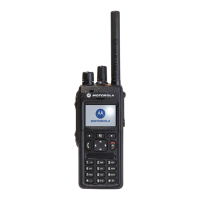Chapter 2
Overview
To achieve a high spectrum efficiency, the radio uses digital modulation technology and sophisticated voice-
compression algorithm. The voice received by the microphone is converted into a digital bit stream consisting
of zeros (0) and ones (1).
This stream is modulated into a radio frequency (RF) signal. It is transmitted over-the-air to another radio.
The process is called digital modulation.
2.1
Digital Modulation Technology
The radio operates in dispatch and phone modes.
The radio also operates in Trunked Mode Operation (TMO) and Direct Mode Operation (DMO). It uses the
π/4 Differential Quadrature PhaseShift Keying (DQPSK) and Time Division Multiple Access (TDMA) digital
technologies.
π/4DQPSK is a modulation technique that transmits information by altering the phase of the signal. Data is
converted into complex symbols, which alter the RF signal and transmit the information. When the signal is
received, the change in phase is converted back into symbols and then into the original data.
The system can accommodate 4-voice channels in the standard 25 kHz channel as used in the two-way
radio. TDMA is used to allocate portions of the RF signal by dividing time into four slots, one for each unit.
Time allocation enables each unit to transmit its data information without interference from other transmitting
units. Transmission from a unit or base station is accommodated in time-slot lengths of 15 ms and frame
lengths of 60 ms. The TDMA technique requires sophisticated algorithms and a Digital Signal Processor
(DSP) to perform voice compressions/decompressions and RF modulation/demodulation.
2.1.1
Voice Compression Technology
Voice is converted into a digital bit stream by sampling the voice at high rate and converting the samples into
numbers, which are represented by bits.
Voice compression reduces the number of bits per second while maintaining the voice at an acceptable
quality level. The radio uses a coding technique called Algebraic Code Excited Linear Prediction (ACELP).
The compressed voice-data bits modulate the RF signal.
2.1.2
Transceiver
All radio circuitry are contained in the Digital/RF board and the keypad board.
The Digital/RF board is divided into the following sections.
● Digital
● Transmitter
● Receiver
● Frequency Generating
68015000841-EL
Chapter 2: Overview
34

